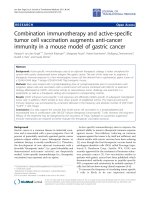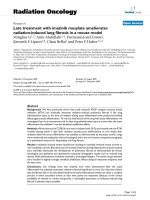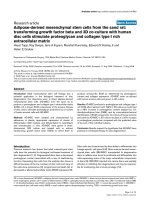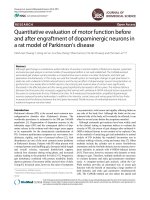Transplantation of mesenchymal stem cells for the treatment of parkinsons disease in a mouse model
Bạn đang xem bản rút gọn của tài liệu. Xem và tải ngay bản đầy đủ của tài liệu tại đây (7.66 MB, 200 trang )
TRANSPLANTATION OF MESENCHYMAL STEM
CELLS FOR THE TREATMENT OF PARKINSON’S
DISEASE IN A MOUSE MODEL
CHAO YIN XIA
DEPARTMENT OF ANATOMY
YONG LOO LIN SCHOOL OF MEDICINE
NATIONAL UNIVERSITY OF SINGAPORE
2008
TRANSPLANTATION OF MESENCHYMAL STEM
CELLS FOR THE TREATMENT OF PARKINSON’S
DISEASE IN A MOUSE MODEL
CHAO YIN XIA
MD
A THESIS SUBMITTED FOR THE DEGREE OF
DOCTOR OF PHILOSOPHY
DEPARTMENT OF ANATOMY
YONG LOO LIN SCHOOL OF MEDICINE
NATIONAL UNIVERSITY OF SINGAPORE
2008
i
ACKNOWLEDGMENTS
First of all, I would like to give my deepest thanks to my mentor,
Associate Professor Tay Sam Wah Samuel, Department of Anatomy, National
University of Singapore, for his inspirational and righteous role model, invaluable
guidance, constant encouragement, infinite patience, and friendly critics throughout
my PhD study.
I am also greatly indebted to Assistant Professor He Bei Ping,
Department of Anatomy, National University of Singapore, for his valuable
suggestions and help during this study.
I am very grateful to Professor Ling Eng Ang, ex-Head of Anatomy
Department, and Professor Bay Boon Huat, current Head of Anatomy Department,
National University of Singapore, for their constant support and encouragement,
and for their full support in using the excellent research facilities.
I would like to express my appreciation to Mrs Ng Geok Lan, Ms Chan
Yee Gek and Dr Wu Ya Jun for their excellent technical assistance; Mr P.
Gobalakrishnan for his constant guidance in photomicrography; Mdm Ang Lye
Gek Carolyne, Mdm Diljit Kaur, Mdm Teo Li Ching Violet for their secretarial
assistance.
I would like to thank all other staff members and my fellow graduate
students at the Department of Anatomy, National University of Singapore for their
help and support.
I am very happy to give thanks to National University of Singapore for
ii
offering me the research scholarship and my supervisor a research grant
(R181-000-096-112), without which this work would not have been brought to a
reality.
I would like to take this opportunity to express my sincere thanks to my
dear parents, brother, sister-in-law and niece for their full and endless support for
my study.
Finally, I am greatly indebted to my beloved husband, Dr Dong Yuan
Hong for his encouragement and endless support during my study.
iii
This thesis is dedicated to my beloved daughter Dong Min for
celebrating 100 days after her birth
iv
PUBLICATIONS
Various portions of the present study have been published or accepted for
publication.
International Journals:
1. Chao YX, He BP, Cao Q, Tay SSW (2007) Protein aggregate-containing
neuron-like cells are differentiated from bone marrow mesenchymal stem cells
from mice with neurofilament light subunit gene deficiency. Neurosci Lett 417(3):
240-5.
2. Chao YX, He BP, Tay SSW. Mesenchymal stem cell transplantation attenuates
blood brain barrier damage and neuroinflammation and protects dopaminergic
neurons against MPTP toxicity in the substantia nigra in a model of Parkinson’s
disease. Submitted, under revision.
3. Chao YX, He BP, Tay SSW. The activating immunoreceptor NKG2D are
involved in MPTP induced Parkinson’s disease models. Manuscript in
preparation.
4. Chao YX, He BP, Tay SSW. Immune potential of mesenchymal stem cells in
vitro. Manuscript in preparation.
Conference publications:
1. Chao YX, Tay SSW, Cao Q, He BP (2005) Effect of NFL gene deficiency on
neuronal differentiation of bone marrow mesenchymal stem cells. Society for
Neuroscience 35
th
Annual Meeting, Washington DC, USA.
2. Chao YX, He BP, Tay SSW (2006) Immune Potential of Mesenchymal Stem
Cells. Society for Neuroscience 36
th
Annual Meeting, Atlanta, USA.
3. Chao YX, He BP, Tay SSW (2007) Increased blood-brain barrier permeability
and infiltration of inflammatory factors in a mouse model of MPTP induced
Parkinson’s disease. 7
th
IBRO World Congress of Neuroscience, Melbourne,
Australia.
4. Chao YX, He BP, Tay SSW (2007) Mesenchymal stem cells transplantation
attenuates peripheral infiltration of inflammatory factors and protects
dopaminergic neurons in the substantia nigra pars compacta against MPTP
toxicity. 7
th
IBRO World Congress of Neuroscience, Melbourne, Australia.
5. Chao YX, He BP, Tay SSW (2007) Activation of JAK/STAT signalling in
dopaminergic neurons following 1-Methyl-4-phenyl-1, 2, 3, 6-tetrahydropyridine
treatment and mesenchymal stem cells transplantation in mice. Society for
Neuroscience 37
th
Annual Meeting, San Diego, USA.
v
6. Chao YX, He BP, Tay SSW (2007) Involvement of peripheral inflammatory
factors in the pathogenesis of MPTP induced Parkinson’s disease. 6
th
ASEAN
Microscopy Conference, Pahang, Malaysia.
vi
TABLE OF CONTENTS
ACKNOWLEDGMENTS………………………………………………………….i
DEDICATIONS……………………………………………………… ………… iii
PUBLICATIONS….………………………………………………………………iv
TABLE OF CONTENTS………………………………………………………vi
ABBREVIATIONS……………………………………………………………
xiv
SUMMARY………………………………………………………………………xix
CHAPTER 1: INTRODUCTION………………………………………… 1
1. Etiology of PD………………………………………………………………… 3
1.1. Genetic mutations in PD…………………………………………………… 3
1.1.1. PARK1 (α-Synuclein, SNCA, PARK4) ……………………………… 4
1.1.2. PARK2 (Parkin, an E3-ubiquitin ligase) …………………………… 4
1.1.3. PARK6: PTEN-induced kinase 1(PINK1)…………………………… 5
1.1.4. PARK7: DJ-1……………… …………………… ………………… 5
1.1.5. PARK8: leucine-rich repeat kinase 2 (LRRK2)… 6
1.2. Environmental factors related to PD ……………………………………… 6
2. Animal models…………………………………………………………………… 7
2.1. The 6-OHDA model………………………………………………………… 7
2.2. The MPTP model……………………………………………… 8
2.3. The rotenone model……………………………………………… 10
vii
2.4. The Paraquat and Maneb………………………………………………… 11
3. Review on the pathogenesis of PD……………………………………………… 12
3.1. Neuronal alteration in the SNc of PD…………………………………… …12
3.1.1. Loss of dopaminergic neurons and Lewy body formation………… 12
3.1.2. Mitochondrial dysfunction and oxidative stress…………………… 13
3.2. Inflammation as a causative factor in the pathogenesis of PD…………… 14
3.2.1. Immune reaction in the CNS of PD……………………………… 14
3.2.2. Involvement of systemic immunity……………………………… …17
3.3. Impairment of the blood-brain barrier…………………………………… 19
4. Review on the management of PD…………………………………………… ….22
4.1. Anti-inflammation………………………………………………………… 22
4.2. Stem cell transplantation………………………………………………… 23
4.2.1. Historical discovery of MSCs……………………………………… 23
4.2.2. Biological characteristics of MSCs………………………………… 24
4.2.3. Proliferation of MSCs……………………………………………… 24
4.2.4. Multipotent differentiation of MSCs……………………………… 25
4.2.5. Immune modulatory effect of MSCs……………………………… 26
4.2.6. Mechanisms of immune modulation of MSCs…………………… 26
4.2.7. Systemic administration of MSCs………………………………… 28
4.2.8. Therapeutic potential of MSCs to treat CNS diseases and injuries… 29
5. Hypothesis……………………………………………………………………… 31
6. Aims of the present study……………………………………………………… 32
viii
6.1. Analysis of the dopaminergic neuron degeneration in the SNc after
MPTP-treatment……………………………………………………… 32
6.1.1. Study of pathological changes of the dopaminergic neurons in the SNc
after MPTP-treatment……………………………………………………… ….32
6.1.2. Study of the activation of microglial cells in the SNc after
MPTP-treatment.………………………………………………………… 33
6.1.3. Study of the changes in integrity of blood-brain barrier in the SNc after
MPTP-treatment………………………………………………………… 33
6.1.4. Study of the peripheral inflammatory response and infiltration in the SNc
after MPTP-treatment…………………………………………………… 33
6.2. Therapeutic effect analysis of MSC transplantation in the MPTP-treated
mice…………………………………………………………………… 34
6.2.1. Rescue of the dopaminergic neurons in the SNc of MPTP-treated mice
after MSC transplantation…………………… 34
6.2.2. Recruitment and destination of MSCs in the SNc after transplantation…35
6.2.3. Suppression of microglia activation in the SNc of MPTP-treated mice after
MSC transplantation………………………………………… 35
6.2.4. Restoration of blood-brain barrier integrity in the SNc of MPTP-treated
mice after MSC transplantation…………………… 35
6.2.5. Suppression of peripheral inflammation in the MPTP-treated mice after
MSC transplantation………………………………………… 36
ix
6.2.6. The expressions of chemockines by MSCs as the potential mechanism of
their immune suppressive effect…………………… 36
6.3. The effect of NFL-/- on the MSC proliferation and differentiation…… 37
CHAPTER 2: MATERIALS AND METHODS………………………………… 38
1. Animal……………………………………… …………………………………39
2. Anaesthesia……………………………………… …………………………39
3. Establishment of PD models and treatment groups………… ………………40
3.1. Experiment groups……………………………………………………… 40
3.2. MPTP administration……………………………………………………… 40
3.3. Tail vein injection of FITC-albumin……………………………………… 40
4. Histological observations… 41
4.1. Perfusion………………………… ………………………………… 41
4.2. Tissue preparations…………………….………………………… 43
4.3. Nissl (Cresyl Fast Violet-CFV) staining……… ……………………… 45
5. Primary culture of MSCs……………………………………………………… 46
5.1. In vitro differentiation assay……………… ……………………………….48
5.2. Cell proliferation assay………………………… ………………………….49
5.3. In vitro analysis of cytokine release of MSCs………………… ……….50
5.3.1. Measurement of TGF-β1 and IL-6 by enzyme-linked immunosorbent
assay (ELISA) ……………… …………………………………….50
x
5.3.2. Immunofluorescence…………………… ………………………….51
5.3.3. Electrophoretic mobility shift assay (EMSA) ……… ……………….52
5.4. Labelling of MSCs with 5-(and-6)-carboxyfluorescein diacetate succinimidyl
ester (CFDA-SE) ……………………………………………………………… 53
6. Immunohistochemistry/Immunocytochemistry………………………………… 53
7. Transmission Electron Microscopy (TEM) …………………………………… 58
7.1. Conventional TEM…………………………… ……………………………58
7.2. Immunoelectron Microscopy……………… ……………………………… 59
8. Reverse transcriptase polymerase chain reaction (RT-PCR) ………………… 60
8.1. RNA isolation…………………… ……………………………………… 60
8.2. One step RT-PCR…………………… …………………………………… 61
8.3. Real time RT-PCR…………………… ………………………………… 63
9. Western Blot assay……………………………………………………………….66
10. Transplantation of MSCs via tail vein of the mice after MPTP-treatment………71
11. Statistical Analysis……………………………………………………………….72
CHAPTER 3: RESULTS………………………………………………………… 73
1. Behavioral changes of MPTP-treated mice………… …………………………74
2. Pathological observations in the MPTP-treated mouse model…… ………… 74
2.1. Morphological studies of dopaminergic neurons in the SNc…………… 74
2.1.1. Nissl staining………………………… ……………………………75
2.1.2. TH staining……………………………… ……………………….76
xi
2.2. Microglial activation at SNc………………………… ………………… 78
2.3. BBB integrity compromise……… ……………………………………….80
2.3.1. Functional study of BBB…………… ………………………………81
2.3.2. Molecular analysis of BBB tight junction……… ………………… 82
2.4. Peripheral inflammatory factors penetration………………………………85
2.4.1. Complement system…………………… ………………………… 85
2.4.2. Natural Killer (NK) cells are involved in MPTP induced Parkinson’s
disease models through the interaction of NKG2D receptor and Rae-1γ ligand… 91
3. Transplantation of MSCs in treatment of PD………………………………….93
3.1. Genetic background of stem cells in stem cell transplantation……………93
3.1.1. Characterization of in vitro cultured MSCs……………… …………94
3.1.2. Effect of NFL knockout on the proliferation of MSCs……… …… 95
3.1.3. Effect of NFL knockout on the neuronal differentiation of MSCs…96
3.2. Therapeutic effect of MSCs transplantation in PD……………………… 99
3.2.1. Systemic MSC transplantation rescue the dopaminergic neurons from
MPTP toxicity…… …………………………………… ……………99
3.2.2. Destination of systemically administered MSCs… ……………….100
3.2.3. Suppression of microglial activation………… ……………………102
3.2.4. Recovery of the impaired BBB………… …………………………103
3.2.5. Suppression of peripheral inflammatory factor activation and brain
infiltration………………………… ……………………………….106
3.2.5.1. Suppression of complement system activation……………… 106
xii
3.2.5.2. Suppression of NK cell activation and recruitment at the SNc 108
4. Immune potential analysis of mesenchymal stem cells…………………… …110
4.1. Cytokine release in vitro…………………………… …………………… 110
4.2. Cytokine release in vivo…………………… …………………………… 112
CHAPTER 4: DISCUSSION……………………………………………………113
1. MPTP-treated mouse as a model to study Parkinson’s disease (PD) …………114
2. Pathogenesis in MPTP induced PD model…………………………………… 117
2.1. Microglial activation in the substantia nigra pars compacta (SNc) after MPTP
treatment…………………………………… …………………… 118
2.1.1. MPTP treatment results in activation of microglia………… …… 118
2.1.2. Possible mechanisms involved in microglial cytotoxicity… …… 119
2.1.3. Possible factors to active microglia in MPTP-PD model… ………121
2.2. BBB integrity compromise……………………………………………….122
2.3. Penetration of peripheral inflammatory factors………………………… 124
2.3.1. MBL………………………………… …………………………….124
2.3.2. NK cells………….………………… ………………………………126
3. Effect of NFL knockout on the proliferation and neuronal differentiation of
MSCs……………………………… ………………………………………….129
3.1. Characterization of in vitro cultured MSCs……………………………….129
3.2. Neuronal differentiation of NFL-/- MSCs…………………… …………….130
3.3. Proliferation of NFL-/- MSCs………………………………………………131
xiii
4. In vitro analysis of immune potential of mesenchymal stem cells…………… 133
5. Systemic MSC transplantation rescue the dopaminergic neurons from MPTP
toxicity………………………………………………………………………… 134
5.1. Rescue of dopaminergic neurons by MSC transplantation… ………… 135
5.2. Suppression of microglial activation after MSC transplantation…………137
5.3. Recovery of the impaired BBB………………… …… ……………… 137
5.4. Suppression of MBL infiltration after MSC transplantation…………… 138
5.5. MSCs transplantation suppress the activation of NK cells in the SNc after
MPTP-treatment………………………………… …………………… 139
CHAPTER 5: CONCLUSION………………………………………………… 140
REFERENCES…………………………………………………………………….145
APPENDIX…………………………………………………………………… 240
xiv
ABBREVIATIONS
ABC avidin-biotin conjugate
AD Alzheimer’s disease
APC antigen-presentation cell
BBB blood-brain barrier
B7H1 B7 homolog-1
BSA bovine serum albumin
CD cluster of differentiation
CNS central nervous system
C1qR C1q receptor
CSF cerebrospinal fluid
CFDA-SE 5-(and-6)-carboxyfluorescein diacetate succinimidyl ester
CFV cresyl fast violet
DAB 3, 3
’
-diaminobenzidine tetrahydrochloride
DAPI 4’, 6- diamidino-2-phenylindole dihydrochloride
DEPC diethyl pyrocarbonate
DMEM Dulbecco's Modified Eagle Medium
DMSO Dimethyl Sulfoxide
DTT dithiothreitol
EAE experimental autoimmune encephalomyelitis
ECL enhanced chemiluminescence
EGF epidermal growth factor
xv
ELISA enzyme-linked immunosorbent assay
EM electron microscopy
EMSA electrophoretic mobility shift assay
ETC electron transport chain
FITC fluorescein isothiocyanate
GA glutaraldehyde
GFAP glial fibrillary acidic protein
HRP horseradish peroxidase
ICAM-1 intercellular adhesion molecule -1
IDO indoleamine 2,3-dioxygenase
IFN- interferon -
IGF insulin-like growth factor
IHC immunohistochemistry
IL-1β interleukin-1β
IL-6 interleukin-6
iNOS inducible nitric oxide synthase
LBs Lewy bodies
LCA leucocyte common antigen
LFA-1 lymphocyte function-associated antigen 1
LIF leukaemia inhibitory factor
LPS lipopolysacharide
LRRK2 leucine-rich repeat kinase 2
xvi
MAC-1 macrophage antigen complex-1
MAO-B monoamine oxidase-B
MAPK mitogen-activated protein kinase
MASPs MBL associated serine proteases
MB maneb
MBLA mannose binding lectin acute
MBLC mannose binding lectin chronic
MCP-1 monocyte chemoattractant protein-1
MHC major histocompatibility complex
MPP+ 1-methyl-4-phenyl-2,3-dihydropyridinium ion
MPTP 1-methyl 4-phenyl 1,2,3,6-tetrahydropyridine
MSC mesenchymal stem cells
mtDNA mitochondrial DNA
NeuN neuronal nuclei
NFH neurofilament heavy chain
NF-κB nuclear factor-κB
NKG2A natural-killer group 2, member A
NKG2D natural-killer group 2, member D
NK natural killer
NFL-/- neurofilament light chain knockout
NO nitric oxide
NSAIDs non-steroidal anti-inflammatory drugs
xvii
PAP peroxidase antiperoxidase
PARs protease-activated receptors
PB phosphate buffer
PBS phosphate buffered saline
PCR polymerase chain reaction
PD Parkinson’s disease
PF paraformaldehyde
PGE2 prostaglandin E2
PINK1 PTEN-induced kinase 1
PPARγ peroxisome proliferators-activated receptor γ
PQ paraquat
RA all-trans-retinoic acid
Rae-1 retinoic acid early inducible gene-1
ROS reactive oxygen species
RT-PCR reverse transcription polymerase chain reaction
SCF stem cell factor
SNc substantia nigra pars compacta
6-OHDA 6-hydroxydopamine
TAE tris-acetate-EDTA
TBS tris buffered saline
TEM transmission electron microscopy
TGF-β1 transforming growth factor-β1
xviii
TH tyrosine hydroxylase
TJ tight junctions
TLR4 toll-like receptor 4
TNF-α tumor necrosis factor-α
VCAM vascular cell adhesion molecule
VE-cadherin vascular endothelial cadherin
VTA ventral tegmental area
ZO zonula occludens
SUMMARY xix
Summary
Neurodegenerative disorders such as Parkinson’s disease (PD), Alzheimer’s
disease (AD) and stroke have seriously influenced the lives of aged people. One of the
most important aspects of neuroscience research is to exploit the pathogenesis of these
diseases and ultimately develop therapeutics to prevent the initiation of
neurodegeneration or protect target neurons from the diseases. Therefore, an
understanding of the mechanisms contributing to neurodegeneration would provide
indications to the development of management.
The degeneration of dopaminergic neurons after 1-methyl-4-phenyl-1,2,3,6-
tetrahydropyridine (MPTP)-treatment in the substantia nigra pars compacta (SNc) of
mice has been well documented. However, the mechanisms underlying the
degeneration remain poorly understood. An inflammatory process in the central
nervous system (CNS) is believed to play an important role in the pathway leading to
neuronal cell death in a number of neurodegenerative diseases. Therefore, this study
has first aimed to investigate the role of innate immune system on the dopaminergic
neuron degeneration in the MPTP-induced PD model. Taken into consideration the
important role of inflammation in PD, immune modulation would be an effective
therapeutic strategy to protect dopaminergic neurons from further attacks.
Mesenchymal stem cells (MSCs) have recently been reported to have an immune
modulatory effect both in vitro and in vivo and after transplantation, MSCs can
migrate to the impaired regions mediated by chemokine-chemokine receptor
interactions. The second aim of this study is to investigate whether the transplanted
SUMMARY xx
MSCs could protect the dopaminergic neurons from MPTP toxicity through
modulating the process of inflammation.
After MPTP treatment, the author has observed the disruption of
blood-brain barrier (BBB) integrity, infiltration of mannose binding lectin (MBL),
activation of microglia, and infiltration of natural killer (NK) cells, as well as loss of
tyrosine hydroxylase (TH) positive dopaminergic neurons in the SNc. The
dopaminergic neuron loss was confirmed from the observation of a degenerative
morphology and significant reduction in the number of TH positive neurons in the
SNc after MPTP-treatment. Immunohistochemistry showed that the microglial cells
became ameboid morphologically and the number of major histocompatibility
complex Class II (MHC II) positive cells increased in the SNc after MPTP-treatment.
Both Western blot analysis and immuno-electron microscopy (EM) results showed the
significant decreases in expression of tight junction molecules such as claudin 1,
claudin 5 and occludin in the BBB. Functional analysis of leakage of fluorescent
labeled albumins from blood vessels further confirmed the compromise of the BBB
integrity. The upregulation of expression of MBL in the liver was induced by MPTP
treatment as shown by Western blot analysis. While immunohistochemistry showed
that MBL was co-localized with MHC II positive microglial cells in the SNc of
MPTP-treated mice, real-time RT-PCR did not find mRNA expression of MBL in the
brain parenchyma, suggesting the infiltration of MBL from the circulation into the
brain. MBL may play an important role in the activation of microglia.
Immunohistochemistry also revealed migration of NK cells into brain parenchyma as
SUMMARY xxi
a consequence of increase in permeability of the BBB. The NK cell activation is
mediated via natural-killer group 2 member D (NKG2D) receptor. Rae-1γ, one of the
NKG2D ligands, was found to co-localize with TH neurons in the SNc of
MPTP-treated mice, indicating that direct interaction between NK cells and impaired
TH neurons in the pathogenesis of MPTP-induced PD.
The immune potential of MSCs and the therapeutic of MSCs transplantation
on the model of MPTP-treated mice have been investigated in the present study. The
author demonstrated, using enzyme-linked immunosorbent assay (ELISA),
immunohistochemistry and electrophoretic mobility shift assay (EMSA), the
expressions of cytokines IL-6 and TGF-β1 in MSCs under the stimulation of
lipopolysaccharide (LPS) in vitro through nuclear factor kappa B (NFB) signaling
pathway. Systematic administration of MSCs rescued the dopaminergic neurons from
MPTP toxicity, which was shown by the prevention of decrease in the number of TH
positive neurons after transplantation. The results have suggested possible
mechanisms, including the following aspects: 1) The expressions of tight junction
molecules claudin 1, claudin 5 and occludin as well as the BBB function were
restored; 2) The MBL expression in liver tissue decreased and infiltration of MBL into
parenchyma decreased after MSC transplantation; 3) Microglial and NK cell
activation were suppressed as shown by the decreased immune staining of MHC II
and NKG2D, respectively; 4) Immunofluorescence identified that the transplanted
MSCs could express IL-6 and TGFβ1 in vivo, suggesting the possibility of MSC
directly influencing the above mentioned processes.
SUMMARY xxii
However, no neuronal marker was found to be co-localized with the
transplanted MSCs in the SNc of MPTP-treated mice at different time points (3, 7, 14
and 28 days post-MPTP-treatment), casting doubt on using MSCs for cell replacement
therapy. Furthermore, the author demonstrated that the MSCs isolated from
neurofilament light chain (NFL) deficient mice carry on the same genetic deficiency
and when transdifferentiation induced with retinoic acid (RA), these NFL-/- MSCs
also could express neuronal marker plus formation of perikaryal protein aggregations,
which were observed in the motor neurons of NFL-/- mice. This finding further urges
scientists to consider seriously the quality of stem cells in cell replacement strategy in
the treatment of various diseases or injuries in the future.
These studies above suggest that the innate immune system activation, such
as microglia, MBL and NK cells, as well as the BBB integrity compromise may take
part in the pathogenesis of MPTP-induced mouse model of PD. MSC transplantation
could rescue the MPTP-induced dopaminergic neuron degeneration. However, the
therapeutic effect of MSCs transplantation may not have resulted from the neuronal
differentiation but resulted from the modulation of MSCs on the innate immune
system and the recovery of BBB. Further investigations are necessary to understand
the underlying signaling pathway(s) of MPTP-induced innate immune system
activation as well as the mechanisms of MSC immune modulation.
INTRODUCTION 1
CHAPTER 1
INTRODUCTION









